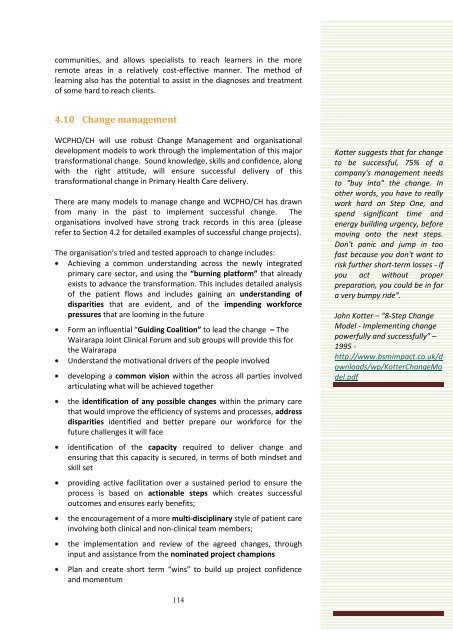Wairarapa Community PHO EOI - New Zealand Doctor
Wairarapa Community PHO EOI - New Zealand Doctor
Wairarapa Community PHO EOI - New Zealand Doctor
You also want an ePaper? Increase the reach of your titles
YUMPU automatically turns print PDFs into web optimized ePapers that Google loves.
communities, and allows specialists to reach learners in the more<br />
remote areas in a relatively cost-effective manner. The method of<br />
learning also has the potential to assist in the diagnoses and treatment<br />
of some hard to reach clients.<br />
4.10 Change management<br />
WC<strong>PHO</strong>/CH will use robust Change Management and organisational<br />
development models to work through the implementation of this major<br />
transformational change. Sound knowledge, skills and confidence, along<br />
with the right attitude, will ensure successful delivery of this<br />
transformational change in Primary Health Care delivery.<br />
There are many models to manage change and WC<strong>PHO</strong>/CH has drawn<br />
from many in the past to implement successful change. The<br />
organisations involved have strong track records in this area (please<br />
refer to Section 4.2 for detailed examples of successful change projects).<br />
The organisation’s tried and tested approach to change includes:<br />
Achieving a common understanding across the newly integrated<br />
primary care sector, and using the “burning platform” that already<br />
exists to advance the transformation. This includes detailed analysis<br />
of the patient flows and includes gaining an understanding of<br />
disparities that are evident, and of the impending workforce<br />
pressures that are looming in the future<br />
Form an influential “Guiding Coalition” to lead the change – The<br />
<strong>Wairarapa</strong> Joint Clinical Forum and sub groups will provide this for<br />
the <strong>Wairarapa</strong><br />
Understand the motivational drivers of the people involved<br />
developing a common vision within the across all parties involved<br />
articulating what will be achieved together<br />
the identification of any possible changes within the primary care<br />
that would improve the efficiency of systems and processes, address<br />
disparities identified and better prepare our workforce for the<br />
future challenges it will face<br />
identification of the capacity required to deliver change and<br />
ensuring that this capacity is secured, in terms of both mindset and<br />
skill set<br />
providing active facilitation over a sustained period to ensure the<br />
process is based on actionable steps which creates successful<br />
outcomes and ensures early benefits;<br />
the encouragement of a more multi-disciplinary style of patient care<br />
involving both clinical and non-clinical team members;<br />
the implementation and review of the agreed changes, through<br />
input and assistance from the nominated project champions<br />
Plan and create short term “wins” to build up project confidence<br />
and momentum<br />
Kotter suggests that for change<br />
to be successful, 75% of a<br />
company's management needs<br />
to "buy into" the change. In<br />
other words, you have to really<br />
work hard on Step One, and<br />
spend significant time and<br />
energy building urgency, before<br />
moving onto the next steps.<br />
Don't panic and jump in too<br />
fast because you don't want to<br />
risk further short-term losses - if<br />
you act without proper<br />
preparation, you could be in for<br />
a very bumpy ride”.<br />
John Kotter – “8-Step Change<br />
Model - Implementing change<br />
powerfully and successfully” –<br />
1995 -<br />
http://www.bsmimpact.co.uk/d<br />
ownloads/wp/KotterChangeMo<br />
del.pdf<br />
114

















